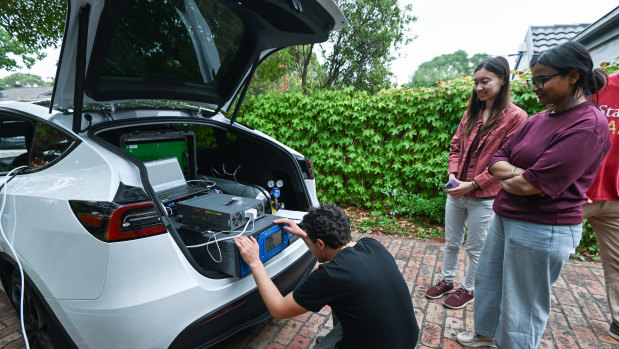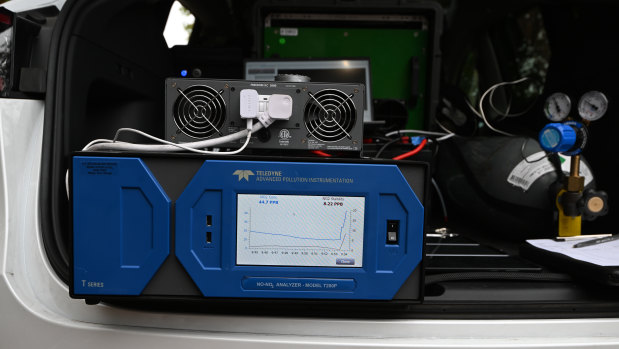
Gas contains methane, a potent greenhouse gas, but it may also contain dozens of other airborne pollutants. And there is a growing body of evidence that cooking indoors with gas is not without health risks.
A study in 2018 published in the Medical Journal of Australia found cooking with gas in Australia increases the burden of asthma by about 12 per cent, or equivalent to the effects of having a cigarette smoker in the home.
“In 2023, any parent who was a smoker wouldn’t dream of smoking around their children, they’d go outside,” Lynch said. “I don’t think people realise that having a gas cooktop is also a risk to their kids’ health.”
The researchers closed all the doors in Lynch’s kitchen and left one gas burner alight, boiling a large pot of water on the stove. No food was cooked.
They used high-tech equipment (stored outside, fittingly, in an electric vehicle) to measure the amount of nitrogen dioxide being emitted, as well as methane, carbon monoxide and carbon dioxide, over the period of half an hour.
The baseline level of nitrogen dioxide was 11ppb (parts per billion) before the burner was turned on, and rose to a peak concentration of 530ppb about half an hour after igniting the burner.

The high-tech measuring equipment was set up outside the house in a no-emission electric vehicle.Credit:Joe Armao
For context, Australia’s nitrogen dioxide standard is 99ppb, averaged over one hour, according to indoor air quality guidelines from the National Construction Code.
For the second experiment, researchers ventilated the home and lit the gas burner with the doors open. This time, the peak nitrogen dioxide level reached 116ppb, and the typical value during the measurement was about 80ppb (these readings were without ventilation). The concentration remained above 50ppb after the stove was turned off and the house was actively aired with doors and windows open and fans on for 10 minutes.
“It is a concern,” said Lynch afterwards. “It certainly made me really aware of how important it is to use the rangehood and having the house open and getting better ventilation.”
Unfortunately, many people forget to use an exhaust fan. One US study in the International Journal of Environmental Research and Public Health found only about 35 per cent of people remember to turn on their extraction hood when they cook, and there is variability in how effective extraction fans are. (It’s worth being cautious when looking at these results, as the sample sizes are small.)

The monitoring equipment shows increasing levels of nitrogen dioxide. Credit:Joe Armao
And you might be surprised to discover that some gas stoves also leak even when they’re turned off. Dr Eric Lebel, one of PSE Healthy Energy’s researchers, has published research looking at the emissions of methane and nitrogen dioxide from gas stoves.
He discovered more than 75 per cent of the methane emissions from gas stoves occurred when they were switched off. All told, Lebel and the other researchers calculated that gas stoves pump 2.6 million tons of methane into the atmosphere each year, or the equivalent of 500,000 cars.
It’s unclear why these stoves are emitting gas while turned off, but Lebel says it’s likely a poorly fitted connection in the appliance. And although these very low levels of methane are not going to cause an explosion, or be enough to smell, these methane leaks still have the potential to damage the climate.
“The gas stove is basically at the end of a gas pipeline and I don’t think people have really thought much about that before,” Lebel said.
This growing body of research into the health effects of gas in the US prompted Richard Trumka Jr, a commissioner of the US Consumer Product Safety Commission to describe gas stoves as a “hidden hazard”. “Any option is on the table,” he told Bloomberg. “Products that can’t be made safe can be banned.”
His comments triggered an outcry among conservative commentators - including one who said if the White House came for their stoves they could “pry it from my cold dead hands.” The Biden administration was forced to issue a statement confirming it had no plans to remove gas stoves.
Loading
Lynch said she would like to see governments put more measures in place to help people transition away from gas cooktops, particularly for renters. These could include low or no-interest loans. “There should be some good initiatives for homeowners and landlords to make this transition,” she said.
Victoria uses more gas than any other state, accounting for almost 40 per cent of domestic gas consumption in Australia’s east coast gas market. The largest volume of this gas – more than 120 petajoules – is used in residential and commercial buildings.
Get to the heart of what’s happening with climate change and the environment. Our fortnightly Environment newsletter brings you the news, the issues and the solutions. Sign up here.









 Add Category
Add Category